Freshwater Harmful Algal Blooms 101
Ugly, foul-smelling and sometimes toxic, algal blooms are becoming more common in freshwater ecosystems like rivers, lakes, ponds, and reservoirs. Here’s a look at how excess algae can impact the environment—and human health.
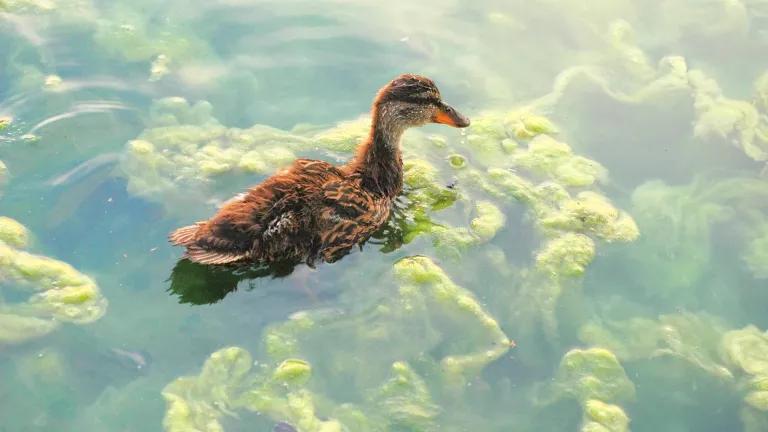
A duck wades through an algae bloom in Florida.
Justin Henry via Flickr
Jump to Section
- What Is an Algal Bloom?
- The Most Common Types of Harmful Algal Blooms
- What Causes Harmful Freshwater Algal Blooms?
- What Are the Effects of Freshwater Harmful Algal Blooms?
- Preventing Freshwater Harmful Algal Blooms
You may have read about algae taking over giant swaths of coastlines, closing beaches and turning the sea a foamy brownish red in a phenomenon known as a red tide. But harmful algal blooms don’t just affect our oceans. They also form in bodies of fresh water, making lakes, ponds, or your favorite swimming hole smelly and slimy. Algal blooms are odious, but more important, they can also be dangerous, imperiling public health and aquatic ecosystems, and costly, affecting local economies. While they aren’t a new phenomenon (Spanish explorers recorded blooms along Florida’s coast in the 1500s), reports of freshwater harmful algal blooms have increased significantly over the past 40 years, and they are now an environmental problem in all 50 states. The U.S. Environmental Protection Agency (EPA) predicts that climate change will only exacerbate the problem. Here’s what you need to know about algal blooms, including their causes and consequences.
What is an algal bloom?
Critical to aquatic food webs, algae are photosynthetic organisms—in other words, they derive energy for growth from the sun. An algal bloom is the overgrowth of microscopic algae or algae-like bacteria in fresh, salt, or brackish waters. Depending on the type of algae or bacteria that cause it, an algal bloom may produce bad-smelling scum, foam, froth, or a paintlike slick. Algal blooms can be many colors, including blue-green, yellow, brown, pink, and red.
Not all algal blooms are toxic, but research indicates that a growing number are. A harmful algal bloom, or HAB, is a bloom that produces toxins that are dangerous to humans and potentially other organisms.
The Most Common Types of Freshwater Harmful Algal Blooms
Any type of algae can proliferate into a HAB under the right conditions. Most freshwater HABs in the United States are produced by cyanobacteria.
Cyanobacteria (blue-green algae)
Cyanobacteria blooms are the most common type of HABs in lakes, ponds, and other freshwater systems in this country, although they can occur in brackish and saltwater environments, too. Cyanobacteria are, as the name suggests, bacteria—but they perform photosynthesis, like algae do, and are often referred to as blue-green algae. Some, though not all, types of cyanobacteria can produce dangerous cyanotoxins. The most frequently reported type of bloom-forming cyanobacteria is Microcystis.
Golden algae
Although found mostly in oceans, golden algae (Prymnesium parvum) are an emerging problem in freshwater rivers, reservoirs, and lakes, particularly those with higher salinity (due to higher mineral content), such as those found in Texas and New Mexico. While a bloom of golden algae can cause massive fish kills, it hasn’t been shown to pose a health threat to humans.
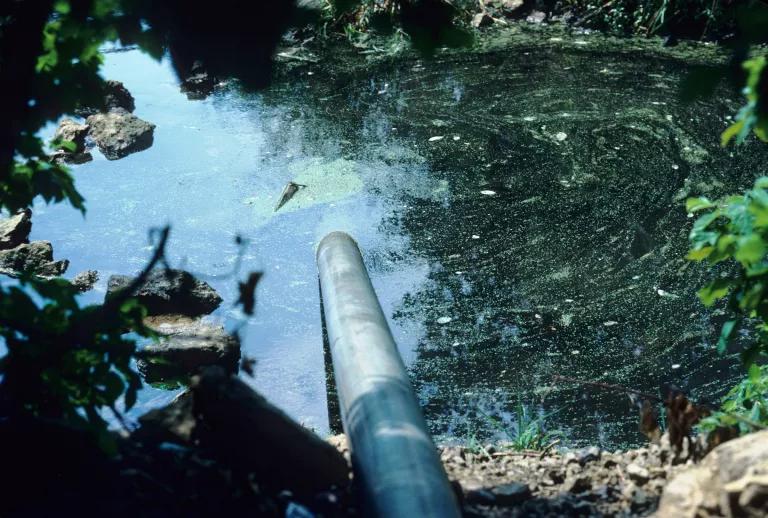
Surface water runoff pipes lead to an algae-filled lake in Wisconsin.
Wisconsin Department of Natural Resources via Flickr
What Causes Freshwater Algal Blooms?
HABs occur both naturally in the environment and as a result of human activities, but the latter are vastly increasing the frequency, prevalence, and toxicity of HABs. The following are some of the main freshwater algal bloom causes:
Nutrient pollution
Nutrients like nitrogen and phosphorus, essential to plant growth, are a natural part of underwater ecosystems. But when they run off urban and rural surfaces and flow into a river, lake, pond, or reservoir in excess—a phenomenon known as nutrient pollution—they act like fertilizer and promote the growth of algae and bacteria. Most excess nutrients enter waterways via agricultural runoff (particularly from animal manure and chemical fertilizers that get washed from farms by rain), leaked waste from animal feedlots, stormwater runoff from urban and suburban areas, and discharges from wastewater treatment facilities. According to the EPA's most recent surveys on national water quality, nutrient pollution in the United States is a problem in more than one-third of lakes and about half of all rivers and streams.
Warm water
Warm water gives cyanobacteria a competitive advantage. These bacteria grow faster than more benign algae in higher temperatures, and once a bloom forms, a feedback loop can be triggered: As blooms grow thicker, the dark surfaces of the algae mats absorb more sunlight, which leads to warmer water and more algal growth.
Still water
Slow-moving or stagnant water can also become thermally stratified, meaning that a layer of warm water, which favors algal blooms, floats on top of cooler water. Factors that contribute to decreased water flow, or ponding, include drought, water extraction for irrigation or drinking, and the alteration of natural waterways via dams, canals, and other man-made infrastructure.
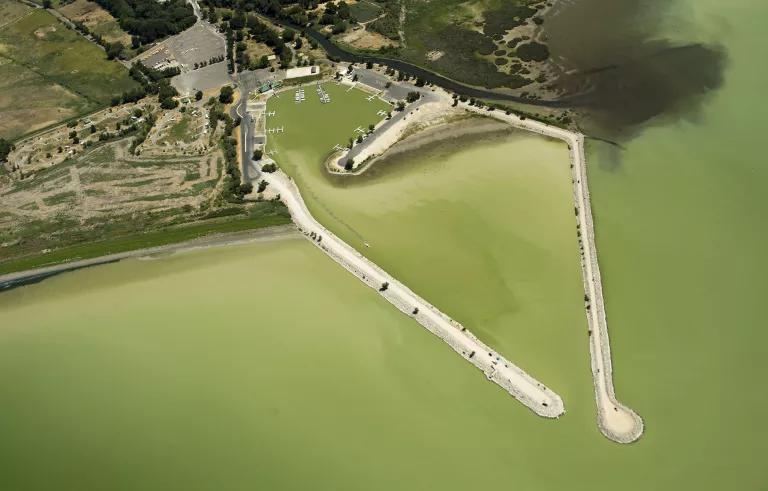
The Lindon Marina in Lindon, Utah, after a harmful algal bloom overwhelmed the lake
Rick Egan/The Salt Lake Tribune via AP
Climate change
Climate change is both increasing the frequency and duration of droughts in many parts of the country and intensifying extreme storms. Periods of drought interspersed with strong precipitation increase runoff from agricultural lands, lawns, and other sources, leading to higher nitrogen levels in rivers—and therefore harmful algal blooms.
Burning fossil fuels, deforestation, and land development are increasing the amount of carbon dioxide in the atmosphere. This fuels harmful algal blooms because cyanobacteria can feed on the carbon dioxide not only present at the surface of a water body but also dissolved in the water. And when algae die and sink to the bottom of a freshwater body, they decompose and release carbon that was once sequestered, providing more fuel for cyanobacteria growth.
Climate change and more severe droughts also modify the flow regime in freshwater bodies and can increase competition for ever-scarcer freshwater supplies. Reduced flows in waterways means the remaining water will be warmer and more stagnant, creating conditions ripe for algal blooms. If we continue to look to natural waterways as our primary source of water and don’t employ efficiency, conservation, and reuse measures to reduce excessive water diversions, freshwater bodies will become more vulnerable than they already are to HABs and the effects of climate change.
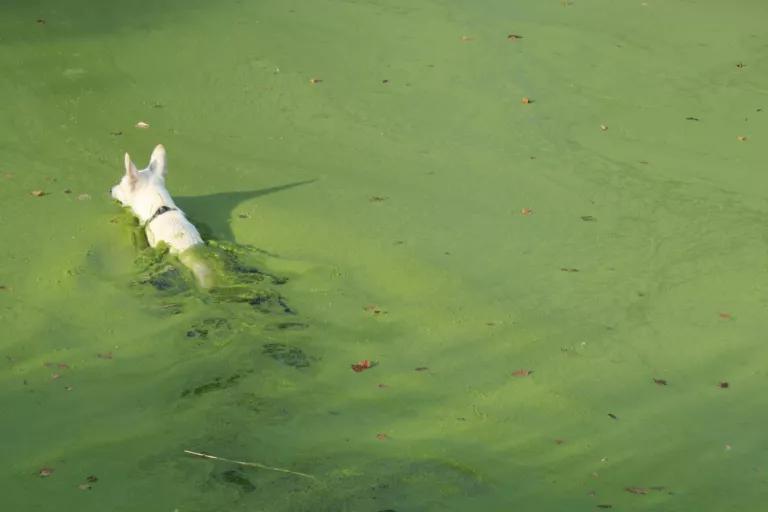
A dog swimming in blooming algae covering a pond in Swepsonville, North Carolina. Dogs are vulnerable to illness or even death after contact with HAB toxins.
Ildar Sagdejev
What Are the Effects of Freshwater Harmful Algal Blooms?
Health risks
People can be exposed to HAB toxins by swallowing or swimming in affected waters, eating poisoned fish or shellfish (even when food is cooked, algal toxins remain), or inhaling airborne droplets of affected water. Depending on the level of exposure and the type of algal toxin, health consequences may range from mild to severe to, in extreme cases, fatal.
Pets are vulnerable to HABs, too—dogs in particular, because they’re most likely to swim in or drink the water. A 2013 paper published in the journal Toxins found 63 dog deaths associated with HABs in 13 states.
There are three classes of cyanotoxins, and each type has different effects:
- neurotoxins, which can cause neurological damage;
- peptide hepatotoxins, which can cause serious damage to the liver; and
- dermatotoxins, which can cause skin irritations and respiratory issues.
The cyanotoxins most frequently reported in freshwater ecosystems are the liver-damaging toxins microcystins and cylindrospermopsin.
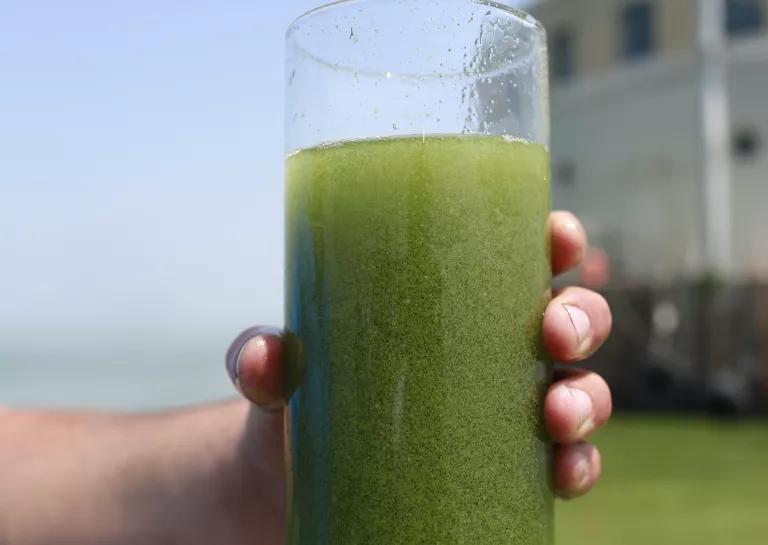
A sample of water pulled from Lake Erie near Toledo, Ohio, after a 2014 toxic algal bloom overwhelmed the lake
Haraz N. Ghanbari/AP Photo
Imperiled drinking water supplies
It is estimated that some 30 million to 48 million Americans get their drinking water from lakes and reservoirs that could be periodically contaminated by algal toxins. And boiling HAB-contaminated water not only doesn’t destroy toxins, but can in fact increase their concentration. Thankfully, drinking-water treatment processes can typically remove algal toxins, such as those from cyanobacteria—but if processing facilities aren’t well maintained and up to date, the bacteria may remain in the water. Inadequate treatment can compromise water quality and threaten public health, and disrupt or even shut down treatment plants. In 2014, for example, a major HAB in Lake Erie prompted the city of Toledo, Ohio, to issue a “do not drink” order for tap water that affected nearly 500,000 people for three days and sickened more than 100. When cyanotoxin levels exceed EPA health advisory levels for tap water, people are at risk of various adverse health effects, from gastrointestinal issues to liver and kidney damage.
Economic costs
HABs cause lakes, reservoirs, and rivers to become unsightly and at times dangerous, reducing tourism, recreation, commercial fishing, and property values and increasing water quality monitoring, management, and treatment costs. While the economic toll of HABs in the United States has yet to be fully assessed, estimates suggest freshwater blooms may cost the nation $4.6 billion annually. Even single bloom events can be crushing for local economies. As one 2015 EPA report found, a persistent algal bloom in an Ohio lake from 2009 to 2010 caused as much as $47 million in lost local tourism revenue.

Left: Dead fish washed ashore during a 2008 golden algae toxic bloom in Texas. Right: A river otter swims in the algae-infested Capitol Lake in Olympia, Washington.
From Left: Mike Hooper/USGS; Jon D. Anderson via Flickr
Sickened animals
The toxins released from a HAB can cause large-scale fish kills (commonly seen as a result of golden algal blooms) and work their way up the food web, impacting mammals, birds, and other wildlife that feed on grasses, shellfish, or fish tainted with toxins.
Texas recently experienced a major fish kill that devastated Lake Texoma, a reservoir on the Oklahoma-Texas border. Approximately 157,000 fish died in just three days due to a golden algae bloom. This was not the first time the lake was hit with this type of bloom. Fish kills in Lake Texoma have been reported since 2004, when almost half of the reservoir’s one million fish died. Statewide, from 2001 to 2010, golden algae blooms caused more than 130 major fish kills and resulted in the loss of more than 34 million fish, costing the Texas economy more than $14 million in revenue.
Dead zones
Even nontoxic HABs can have a detrimental impact on aquatic ecosystems in the form of dead zones, areas in a water body with so little oxygen that aquatic life can’t survive. Also known as hypoxic zones, dead zones are typically a result of eutrophication, which is what happens when a waterway becomes overly polluted with nutrients. When algae and bacteria in an algal bloom die, the decomposition process uses up most of the surrounding oxygen, causing other organisms in an affected water body to suffocate and die or be forced to relocate to survive.
According to the EPA, more than 166 dead zones have been reported nationwide. The largest, in the northern Gulf of Mexico, demonstrates how nutrient pollution from the basin of the Mississippi River, a freshwater river, can impact coasts and saltwater bodies. This dead zone has reappeared each year in recent decades and varies in size. Experts predict 2019 will rival 2017 as the largest yet, with the dead zone at the mouth of the Mississippi River expected to occupy more than 8,500 square miles, an area the size of Massachusetts.
Increased turbidity
A bloom of algae on the water’s surface creates a turbid (cloudy) underwater environment, one that prevents much of the sun’s light from reaching bottom-dwelling organisms, including plants. Underwater plants are often a critical source of food and shelter for other organisms, and without them entire aquatic food webs and ecosystems can suffer. Between the 1970s and 2000s, for example, darker water due in part to algal blooms killed off much of the eelgrass in the Chesapeake Bay area. This loss of critical habitat contributed to the decimation of blue crab populations, which plummeted by nearly 70 percent between the early 1990s and 2007.

A blue crab caught in the Chesapeake Bay north of Deal Island, Maryland
Will Parson/Chesapeake Bay Program
Preventing Freshwater Harmful Algal Blooms
Over the past few decades, HABs have increased in frequency and distribution, and the climate crisis we’ve created is exacerbating conditions that favor HABs. Curbing climate change and adopting better regulations to reduce nutrient pollution will help reduce HABs and mitigate their toll on human health, ecosystems, and local economies.
Better farming practices
On farms, regenerative practices that improve soil health help to capture rain where it falls instead of allowing nutrient-packed runoff to wash into bodies of water. These practices include planting cover crops, diversifying what’s grown, reducing tillage, properly applying compost and manure, and following fertilizer best practices. NRDC is working to expand adoption of these good practices by partnering with states and others to financially reward farmers who plant cover crops, by seeking to improve federal initiatives like the federal crop insurance program to empower farmers to adopt regenerative farming practices, and by working to incentivize smart cultivation practices in the Farm Bill, a law that sets agricultural policies.
Green infrastructure
As mentioned above, it’s not just farms that produce tainted runoff. The EPA estimates that 10 trillion gallons of untreated stormwater washes off paved surfaces every year, through storm sewer systems, and into waterways. This runoff can contain high levels of nutrients that can trigger HABs. The solution, which NRDC works toward, is to use more green infrastructure in cities. Adding green roofs, planting trees, and building gardens of rain-absorbing plants all capture rainwater before it flows into waterways.
Smart water policies and conservation
Protecting wetlands, which act as natural filters to improve water quality, capture runoff, and enhance biodiversity, is also vital. The law that protects our nation’s wetlands, the Clean Water Act, is under threat by the Trump administration. The administration wants to exclude more than half of the nation’s wetlands from protection. NRDC is fighting these rollbacks.
In many parts of the country, diverting water from rivers for consumption by cities, agriculture, and other uses has significantly changed waterways and their surrounding habitats and put the health of our rivers, lakes, and vital ecosystems at risk. Diverting more than 80 percent of a river’s natural flow is not uncommon in parts of the western United States, where major river systems like the Colorado, the Rio Grande, and the San Joaquin run dry for vast stretches due to upstream diversions. Excessive diversions create the warm, stagnant conditions in which HABs thrive. Harmful algal blooms have proliferated in recent years in communities around the Sacramento-San Joaquin River Delta, the West Coast’s largest estuary, as river flows have waned. NRDC works with government agencies, local communities, and businesses to develop practical strategies for reducing excessive diversions from rivers and lakes while providing alternative, sustainable water supplies for growing populations and economies.
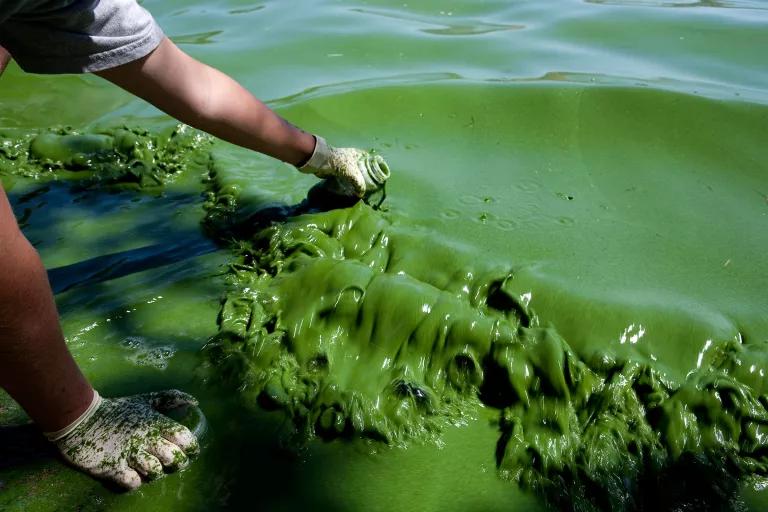
A water quality researcher takes samples of a toxic blue-green algae bloom in the Copco Reservoir in California.
David McLain/Alamy
Monitoring, mitigation, and collaboration
Improved monitoring and increased research into HABs is also much needed. There is no nationwide system for collecting data on and responding to HABs, and the type of information available on HABs in individual states varies greatly. Improved methods of communication to the public, across organizations, and among states could speed up emergency response to HABs, reducing harm to the environment, wildlife, and people. Congress funds research on the best ways to prevent and mitigate HABs with support for groups including the National Oceanic and Atmospheric Agency (NOAA) and the EPA. Congress also provides funding to the U.S. Geological Survey (USGS) to research algal toxins. The EPA, NASA, NOAA, and USGS formed the Cyanobacteria Assessment Network (CyAN) to collect, analyze, and distribute real-time satellite data to help state agencies more quickly detect cyanobacteria outbreaks in U.S. lakes and reservoirs. The network has also made satellite images of HABs more accessible to the public. While the federal government is investing in research and prevention programs, a concerted national effort to identify, respond to, and prevent HAB outbreaks is lacking—and that endangers public health.
States are currently on the front line of the HAB crisis and need to do more to protect their residents from exposure to toxic blooms. Thankfully, some states have improved monitoring and reporting efforts. For instance, in 2017 there were 41 confirmed reports of HABs in Montana waters. The state responded by creating a guide for addressing HABs, launching a public awareness campaign, and posting signs at lakes, ponds, rivers, campgrounds, and fishing spots that ask for the public’s help in locating HABs. Unfortunately, too many states fail to even monitor for HABs and alert the public of their risks, let alone take significant steps to reduce outbreaks in the first place.
Knowing where HABs are occurring—and whether the government is responding—is a critical first step to keeping our waterways, families, and ecosystems safe.
This NRDC.org story is available for online republication by news media outlets or nonprofits under these conditions: The writer(s) must be credited with a byline; you must note prominently that the story was originally published by NRDC.org and link to the original; the story cannot be edited (beyond simple things such as grammar); you can’t resell the story in any form or grant republishing rights to other outlets; you can’t republish our material wholesale or automatically—you need to select stories individually; you can’t republish the photos or graphics on our site without specific permission; you should drop us a note to let us know when you’ve used one of our stories.

A Fearless Defender for Our Future
Tastes Great, Less Drilling
In Planning for Climate Change, Native Americans Draw on the Past